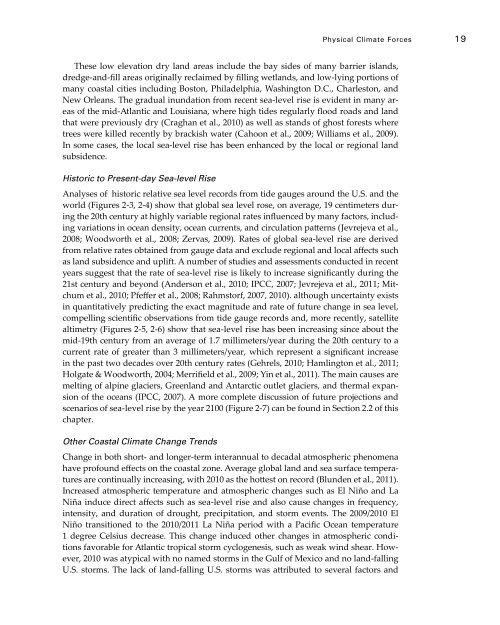Coastal Impacts, Adaptation, and Vulnerabilities - Climate ...
Coastal Impacts, Adaptation, and Vulnerabilities - Climate ...
Coastal Impacts, Adaptation, and Vulnerabilities - Climate ...
Create successful ePaper yourself
Turn your PDF publications into a flip-book with our unique Google optimized e-Paper software.
Physical <strong>Climate</strong> Forces 19These low elevation dry l<strong>and</strong> areas include the bay sides of many barrier isl<strong>and</strong>s,dredge-<strong>and</strong>-fill areas originally reclaimed by filling wetl<strong>and</strong>s, <strong>and</strong> low-lying portions ofmany coastal cities including Boston, Philadelphia, Washington D.C., Charleston, <strong>and</strong>New Orleans. The gradual inundation from recent sea-level rise is evident in many areasof the mid-Atlantic <strong>and</strong> Louisiana, where high tides regularly flood roads <strong>and</strong> l<strong>and</strong>that were previously dry (Craghan et al., 2010) as well as st<strong>and</strong>s of ghost forests wheretrees were killed recently by brackish water (Cahoon et al., 2009; Williams et al., 2009).In some cases, the local sea-level rise has been enhanced by the local or regional l<strong>and</strong>subsidence.Historic to Present-day Sea-level RiseAnalyses of historic relative sea level records from tide gauges around the U.S. <strong>and</strong> theworld (Figures 2-3, 2-4) show that global sea level rose, on average, 19 centimeters duringthe 20th century at highly variable regional rates influenced by many factors, includingvariations in ocean density, ocean currents, <strong>and</strong> circulation patterns (Jevrejeva et al.,2008; Woodworth et al., 2008; Zervas, 2009). Rates of global sea-level rise are derivedfrom relative rates obtained from gauge data <strong>and</strong> exclude regional <strong>and</strong> local affects suchas l<strong>and</strong> subsidence <strong>and</strong> uplift. A number of studies <strong>and</strong> assessments conducted in recentyears suggest that the rate of sea-level rise is likely to increase significantly during the21st century <strong>and</strong> beyond (Anderson et al., 2010; IPCC, 2007; Jevrejeva et al., 2011; Mitchumet al., 2010; Pfeffer et al., 2008; Rahmstorf, 2007, 2010). although uncertainty existsin quantitatively predicting the exact magnitude <strong>and</strong> rate of future change in sea level,compelling scientific observations from tide gauge records <strong>and</strong>, more recently, satellitealtimetry (Figures 2-5, 2-6) show that sea-level rise has been increasing since about themid-19th century from an average of 1.7 millimeters/year during the 20th century to acurrent rate of greater than 3 millimeters/year, which represent a significant increasein the past two decades over 20th century rates (Gehrels, 2010; Hamlington et al., 2011;Holgate & Woodworth, 2004; Merrifield et al., 2009; Yin et al., 2011). The main causes aremelting of alpine glaciers, Greenl<strong>and</strong> <strong>and</strong> Antarctic outlet glaciers, <strong>and</strong> thermal expansionof the oceans (IPCC, 2007). A more complete discussion of future projections <strong>and</strong>scenarios of sea-level rise by the year 2100 (Figure 2-7) can be found in Section 2.2 of thischapter.Other <strong>Coastal</strong> <strong>Climate</strong> Change TrendsChange in both short- <strong>and</strong> longer-term interannual to decadal atmospheric phenomenahave profound effects on the coastal zone. Average global l<strong>and</strong> <strong>and</strong> sea surface temperaturesare continually increasing, with 2010 as the hottest on record (Blunden et al., 2011).Increased atmospheric temperature <strong>and</strong> atmospheric changes such as El Niño <strong>and</strong> LaNiña induce direct affects such as sea-level rise <strong>and</strong> also cause changes in frequency,intensity, <strong>and</strong> duration of drought, precipitation, <strong>and</strong> storm events. The 2009/2010 ElNiño transitioned to the 2010/2011 La Niña period with a Pacific Ocean temperature1 degree Celsius decrease. This change induced other changes in atmospheric conditionsfavorable for Atlantic tropical storm cyclogenesis, such as weak wind shear. However,2010 was atypical with no named storms in the Gulf of Mexico <strong>and</strong> no l<strong>and</strong>-fallingU.S. storms. The lack of l<strong>and</strong>-falling U.S. storms was attributed to several factors <strong>and</strong>
















